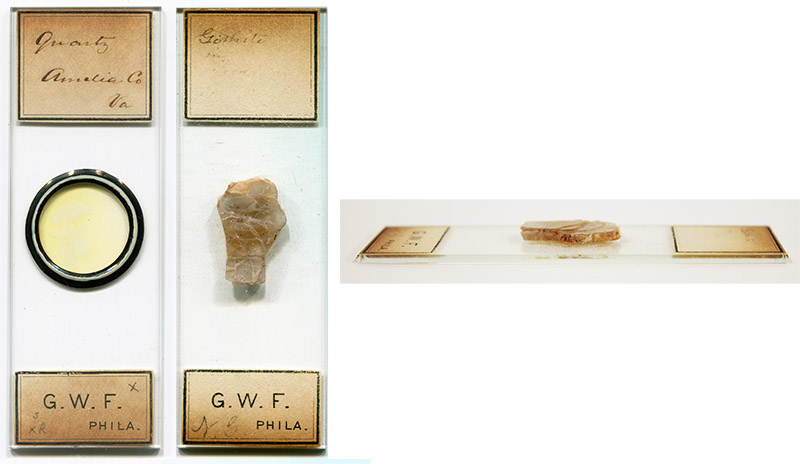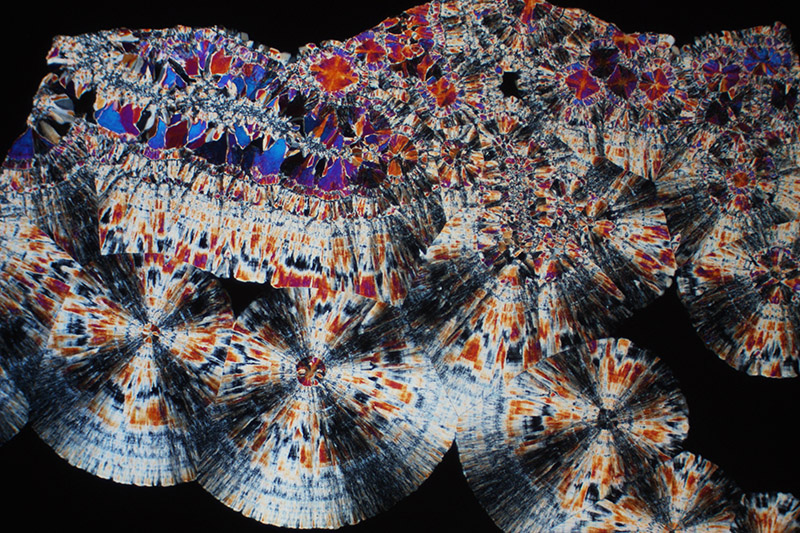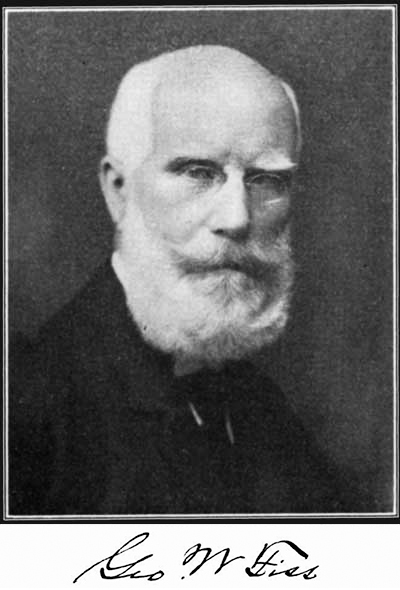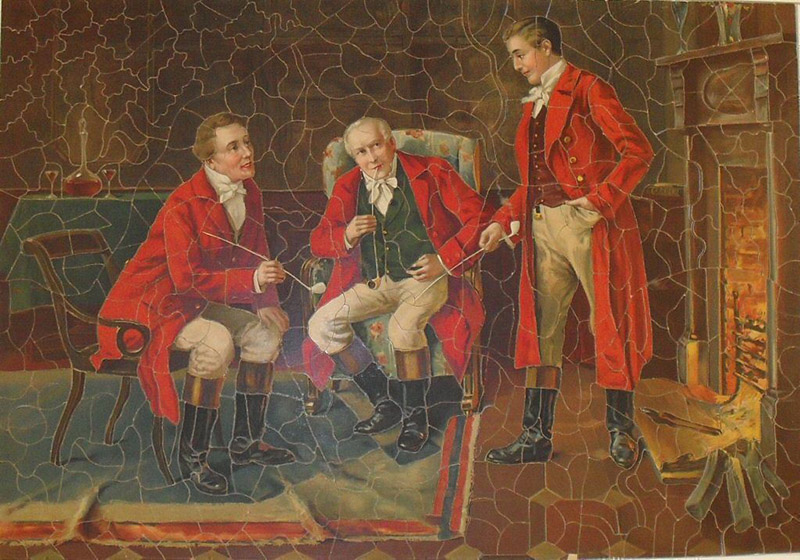George Washington Fiss, 1835 - 1925
by Brian Stevenson
last updated June, 2017
George W. Fiss was one of the world’s first makers of mineral micromounts, that is, small specimens of minerals intended for viewing under a microscope. Two advantages of this format is that specimens do not take up much space, and their structures are readily observed in microscopic detail.
Fiss produced two large collections of mineral micromounts, with the specimens held inside small cardboard containers (Figure 4). The majority of those specimens are currently held in the Harvard University Mineralogical Museum and in a private collection. A few items appear to have been separated from those groupings, and are scattered in various other collections.
He also mounted minerals on glass slides (Figure 1). These consist of both thinly-ground, transparent specimens, and small fragments of minerals. Such slides are somewhat common nowadays, suggesting that Fiss made a modest number of glass-mounted specimens.
These were prepared as a hobby. As a profession, Fiss owned a worsted yarn manufacturing business.

Figure 1.
Two examples of mineral specimens that G.W. Fiss mounted on 1x3 inch glass slides. The quartz specimen on the left was thinly-ground, and mounted under a cover-slip (probably in balsam). The specimen of göthite is about 1 mm thick, and was not polished on either side.

Figure 2.
A thin section of quartz, mounted by G.W. Fiss (see Figure 1). Photographed with a C-mounted digital SLR camera through a 3.4x objective lens, with crossed polarizing filters (polariscope), without a selenite or other colored filter.

Figure 3.
Photograph of George W. Fiss. Adapted for nonprofit, educational purposes from http://www.minrec.org/labels.asp?colid=460 and from Wilson et al., 2008.
George Washington Fiss was born in Philadelphia, Pennsylvania in March, 1835. His father, also named George, was a shoemaker.
G.W. Fiss married Ellen Mehl in 1860, in Philadelphia. They had 5 children, all girls. Ellen died in 1870, probably from complications with the birth of their fifth child. The eldest daughter, Elizabeth, did not marry and remained with her father until his death. The Fiss family lived a fairly comfortable life from the profits of George’s woolen mills, with 2-3 live-in servants.
It is reported that Fiss began collecting minerals during the 1870s. Later records of the Academy of Natural Sciences of Philadelphia noted that Fiss occasionally displayed minerals, without mentioning them being micromounts, so he presumably continued to collect large specimens.
Around 1881, he hit upon the idea of collecting and mounting small specimens. Although others also came up with that notion, he appears to have been unaware, and so is considered one of the fathers of micromounting. In a later letter, Fiss wrote, “I began making a collection of these micro minerals in 1881, when I found I had neither time nor money to make a collection of first class cabinet specimens and so decided to gather crumbs that came from your big collectors tables and I believe I am the first to attempt to gather these scraps systematically”.
He initially mounted his specimens in round, covered brass devices that were glued onto glass slides. While this method is suitable for a few samples, which can be stored along with more standard microscope slides, it takes up more space than necessary, uses fragile glass and expensive brass containers, and the glass is completely unnecessary for viewing opaque specimens that require top-lighting. Fiss soon switched to mounting samples in covered cardboard boxes (Figure 4). Each specimen was glued to a small piece of cork, which was attached to the inside of the box. Box insides were painted black, to reduce background reflections. Labels on the bases and lids identified the specimens, and noted the best angle for lighting.
In addition, Fiss evidently prepared more standard microscope slides of mineral specimens. The specimens shown in Figure 1 are thin and transparent, so mounting on glass slides would be a reasonable approach. Both standard and polarized transmitted light could be used (Figure 2).
The hobby of micromounting became a passion for Fiss. A colleague, Charles Palanche, later recalled, “Mr. George W. Fiss was a noble looking man, tall with a full snowy white beard, splendid carriage and a most charming voice and smile. He was, I believe, a cotton manufacturer but his business never came to the fore in our meetings. On my rare visits to Philadelphia he would promptly give me a huge and very strong cigar and plant me at his rotating table with the tall Zentmayer binocular microscope. He always had new mounts and problems of identification. Hours would pass, and between the fumes of nicotine, the smell of the paraffin lamp which he always used, and eyestrain, I would find myself physically exhausted until I could not tell quartz from galena at the evening's end. But I found an unending fascination in his careful preparations. I believe he much advanced the art of making these mounts. He was a dear friend, modest - kind - humble”.
Fiss made two major collections of micromounts, one for himself, and one for colleague Clarence S. Bement (1843-1923). Bement was a serious collector of large “cabinet” specimens. Fiss wrote, “Bement from the first took a warm interest in what I was doing. Together we went over his large collection and broke off any micro things when it could be done without injury to the cabinet specimen. Whenever there was a duplicate, I mounted it and set it aside for him, for he said ‘if ever I part with my large minerals I will take up this branch’. In this way up to when he sold his collection I had accumulated for him quite a good many mounts including material I had gotten from dealers and correspondents in the West and elsewhere. He also bought a selection of 500 mounts from (George G. Rakestraw, [1827-1904]) who had taken up the work. All these I remounted for him”. Bement sold his collection of large specimens in 1900, then took up collecting micro-minerals.
Sometime afterward, Bement’s eyesight failed to the point that he could no longer enjoy his micromounts, and he sold them to Fiss. He picked through Bement’s collection, keeping about a third to a half of the specimens, replacing other mounts with his own, plus adding about 125 mounts made by other collectors. Fiss sold this collection of 2278 mounts in 1912 to Albert F. Holden (1863-1913). Holden died the next year, and the collection passed to the Harvard University Mineralogical Museum.
G.W. Fiss died on April 19, 1925. His personal collection of micromounts passed to Frank J. Keeley (1868-1949). Keeley presented it to the Academy of Natural Sciences of Philadelphia in 1949. In 2007, it was sold to a private collector.
In addition to his interests in minerals and micro-mounting, Fiss was an enthusiastic bird-watcher, botanist, and maker of jigsaw puzzles (Figure 5). This latter hobby is worthy of elaboration. Making, then assembling, hand-made jigsaw puzzles was a popular pastime in the early 1900s. A picture would be pasted onto a thin board, then cut into various irregular shapes. Fiss worked with a treadle-powered saw. He was adept at cutting along edges between colors, to make it difficult for the assembler to know what pieces should go next to each other. Making things even more difficult, such puzzles were not provided with an image of the final picture. Puzzlers considered such a clue to be cheating. After all, the purpose was to while away time in those days before radio, TV, and internet.

Figure 4.
Cabinet, a drawer, and top & bottom views of a specimen box from G.W. Fiss’ personal micromount collection. Adapted for nonprofit, educational purposes from http://www.minrec.org/labels.asp?colid=460

Figure 5.
A circa 1913 jigsaw puzzle that was made by G.W. Fiss. The picture was glued to a board, then hand-cut with a treadle-powered saw. Note that many of the pieces are cut along color lines, making it difficult for the assembler to know which would go together. Fiss shared this jigsaw puzzle among a wide number of friends and neighbors. A picture of the final assembly was not provided - puzzle makers of the day considered that to be cheating - and was assembled without knowing what it would turn out to look like. Adapted for nonprofit, educational purposes from http://www.museumofplay.org/blog/play-stuff/2014/08/a-family-of-meticulous-puzzle-cutters
Acknowledgements
My thanks to Wendell Wilson for his excellent on-line Mineralogical Record, http://www.minrec.org/index.asp
Resources
Annual Report of the Secretary of Internal Affairs of the Commonwealth of Pennsylvania (1888) Worsted yarn manufacturing in Pennsylvania, Vol. 16, document 14, pages D1-D3
Journal of the Mineralogical Society of America (1925) “Mr. Keeley announced the death, on April 19, 1925, of Mr. George W. Fiss, of Philadelphia. Mr. Fiss was a pioneer in the collection of mineral specimens for study under the microscope, and his enthusiasm in this direction was of great influence in promoting the use of this instrument among mineral collectors”, page 179
Palache, C. (1951) Recollections of three Philadelphia mineralogists, Rocks and Minerals, Vol. 26, pages 456-459
Proceedings of the Academy of Natural Sciences of Philadelphia (1884) Minutes of the meeting of February 26, “Messrs. Geo. W. Fiss and Francis E. Emory were elected members”, Vol. 36, page 47
Ricketts, N. (2014) A family of meticulous puzzle cutters: Fiss puzzles at The Strong, Play Stuff Blog, http://www.museumofplay.org/blog/play-stuff/2014/08/a-family-of-meticulous-puzzle-cutters
Wight, Q. (1993) The Complete Book of Micromounting, Mineralogical Record, Tuscon
Wilson, W.E., R.H. Currier, C.A. Francis, S White (2008) George Washington Fiss (1835-1925) and his micromount collection, Mineralogical Record, Vol. 39, pages 111-122
Wilson, W.E. (accessed June, 2017) George Washington Fiss, The Mineralogical Record Biographical Archive, http://www.minrec.org/labels.asp?colid=460




